If you aren’t familiar with Responsive Search Ads, a good way to think of them is giving Google a bunch of different text components to mix and match while it finds the best combinations. There’s a learning period for any new RSA, which means performance may not be what you’re used to right away.
With this transition from Expanded Text Ads (ETAs) to Responsive Search Ads (RSAs) comes a host of questions about the performance of RSAs, the need to display key information in your ad text, and how to manage the transition to PPC campaigns composed solely of RSAs.
Of course, third-party tools like Optmyzr can help identify the best-performing components of your current ads and even help you build RSAs from scratch. But it never hurts to know where things stand as you plan to build your RSAs.
In this article, you’ll find the results of our study on RSA performance, answers to some pressing questions about the transition, and advice on how to retain control of your search campaigns with RSAs.
How and what we analyzed
Our 2022 study of RSA performance covers 13,671 randomly chosen Google Ads accounts in Optmyzr and answers questions like:
- Is RSA usage as common among advertisers as you think?
- How does RSA performance compare to that of ETAs?
- What effect do pinned headlines/descriptions have on performance?
We’ve presented the results by category so you can quickly find what’s most relevant to your goals.
Watch Frederick Vallaeys present the study on PPC Town Hall below.
Get actionable PPC tips, strategies, and tactics from industry experts twice a month.
Key findings from our Responsive Search Ads data analysis
Here’s our CEO Frederick Vallaeys on what the study taught us about the relationship between PPC marketers and Responsive Search Ads.
“The biggest insight is that advertisers have focused on the wrong metric. Responsive Search Ads have a better click-through rate but a lower conversion rate. This upsets advertisers because when they A/B test, they assume that the ad group has a fixed number of impressions and that by showing lower-converting ads for these impressions, conversions will go down (and costs up). Google, meanwhile, is happy because there are more clicks.”
But this is an incomplete picture.
“What our study shows is that impressions for an ad group are highly dependent on the ad, and RSAs drive 4x the impressions of a typical ETA. Even with a slightly lower conversion rate, this 400% lift in impressions nets a lot of incremental conversions that should make advertisers very happy.”
Responsive Search Ads have a better auction-time Quality Score, so they help you qualify for more auctions. They also boost ad rank and give you access to entirely new search terms (and impressions). As a result, ad-level performance and metrics like click-through or conversion rate may not paint a full picture of your performance.
Evaluate the success of your ads based on the incremental impressions, clicks, and conversions your ad groups and campaigns receive.
Statistics on Responsive Search Ad usage
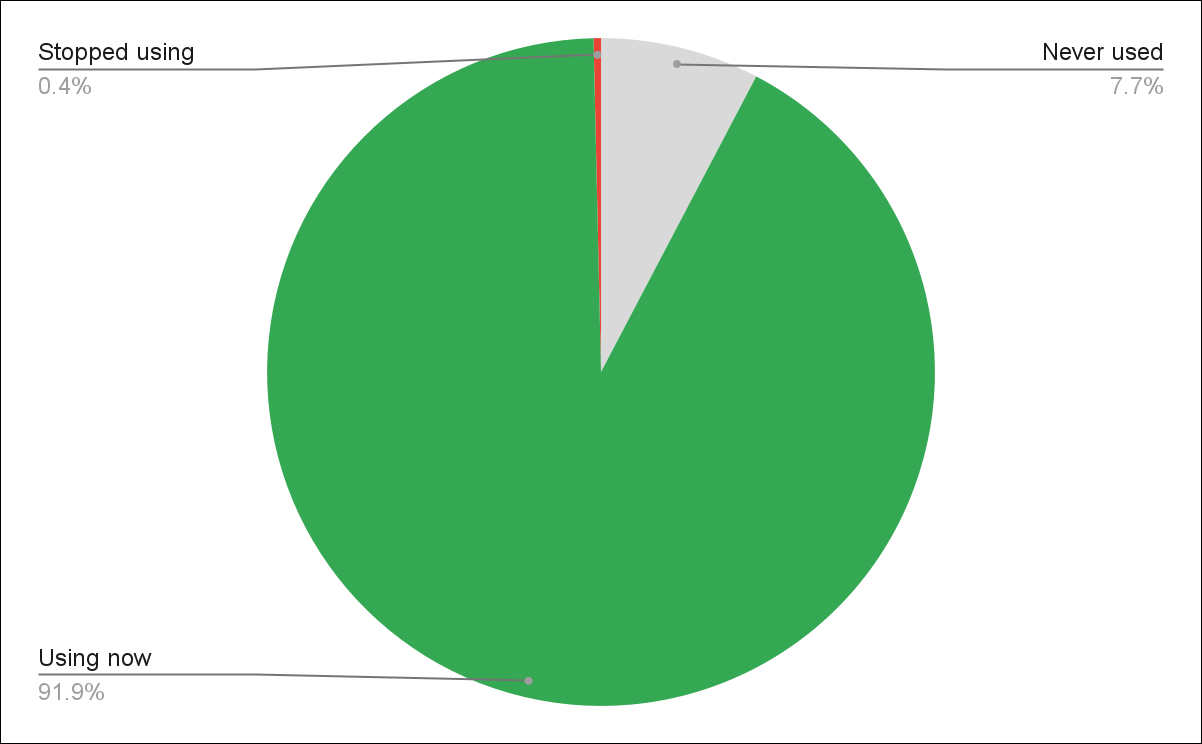
This year, out of the 13,671 accounts we analyzed:
- 7.7% have never built a single RSA
- 92% currently have at least one active RSA
- 0.4% had RSAs but stopped using them
Optmyzr’s Interpretation: Most advertisers are already well on their way to transitioning to Responsive Search Ads, and those who have experimented with the new ad format tend to like the results enough to keep RSAs active.
Statistics on Responsive Search Ads and pinning
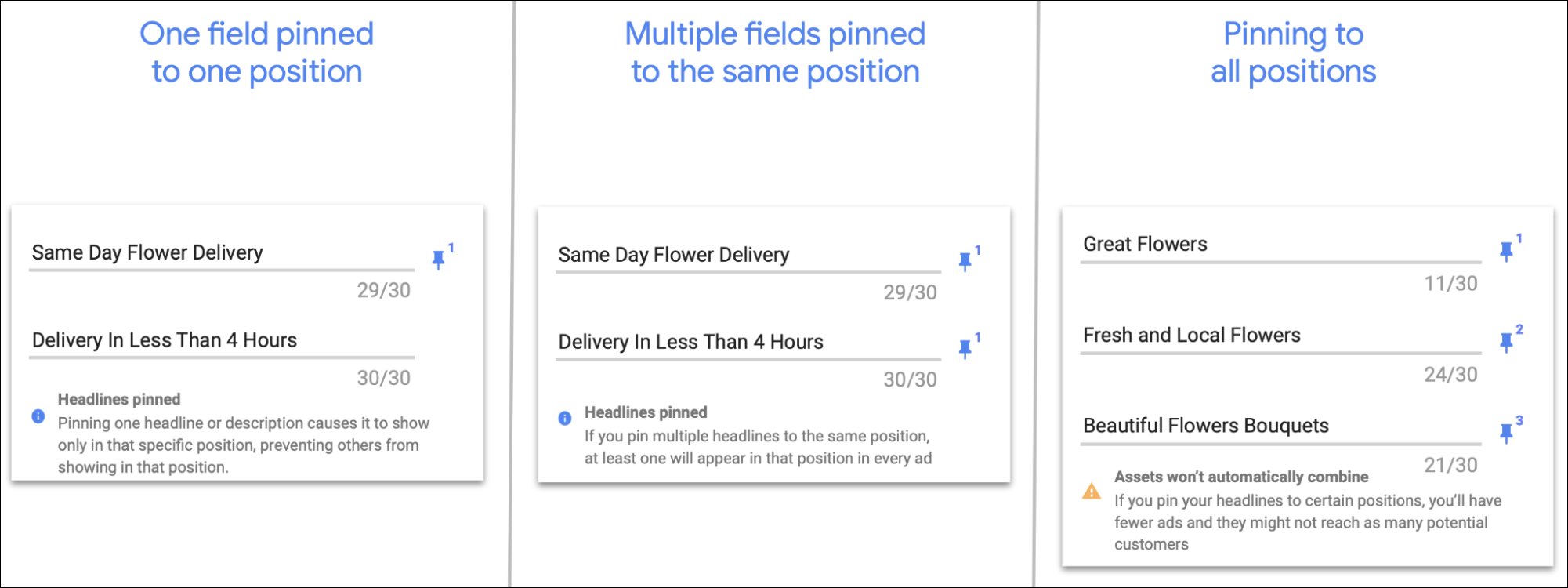
Pinning – fixing headlines or descriptions to specific positions – gives you more control over how your RSAs appear to users. But it also reduces your ad strength, according to Google.
In our analysis of over 93,055 Responsive Search Ads, we looked at the impact of three ways to pin: no pinning, pinning only some ad positions, and pinning all ad positions.
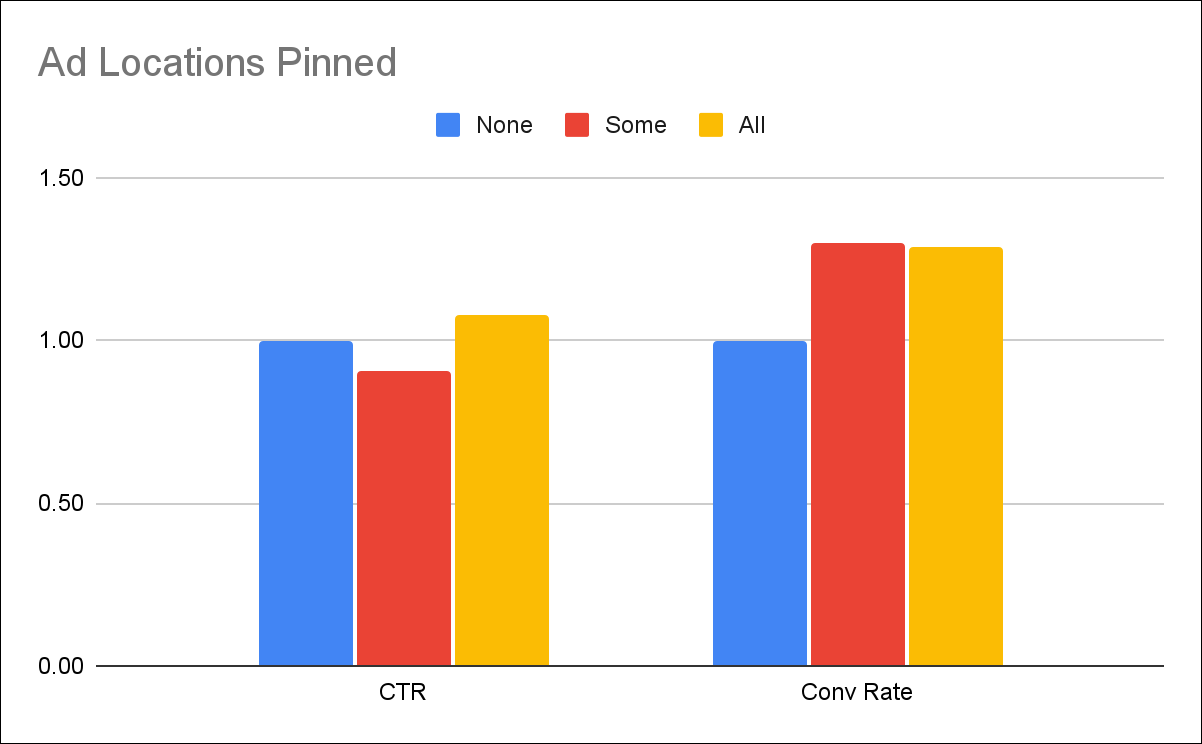
We found that RSAs that pin every position have great metrics like CTR and Conversion Rate, which makes sense for advertisers who’ve done great A/B testing for years and have hyper-optimized ads.
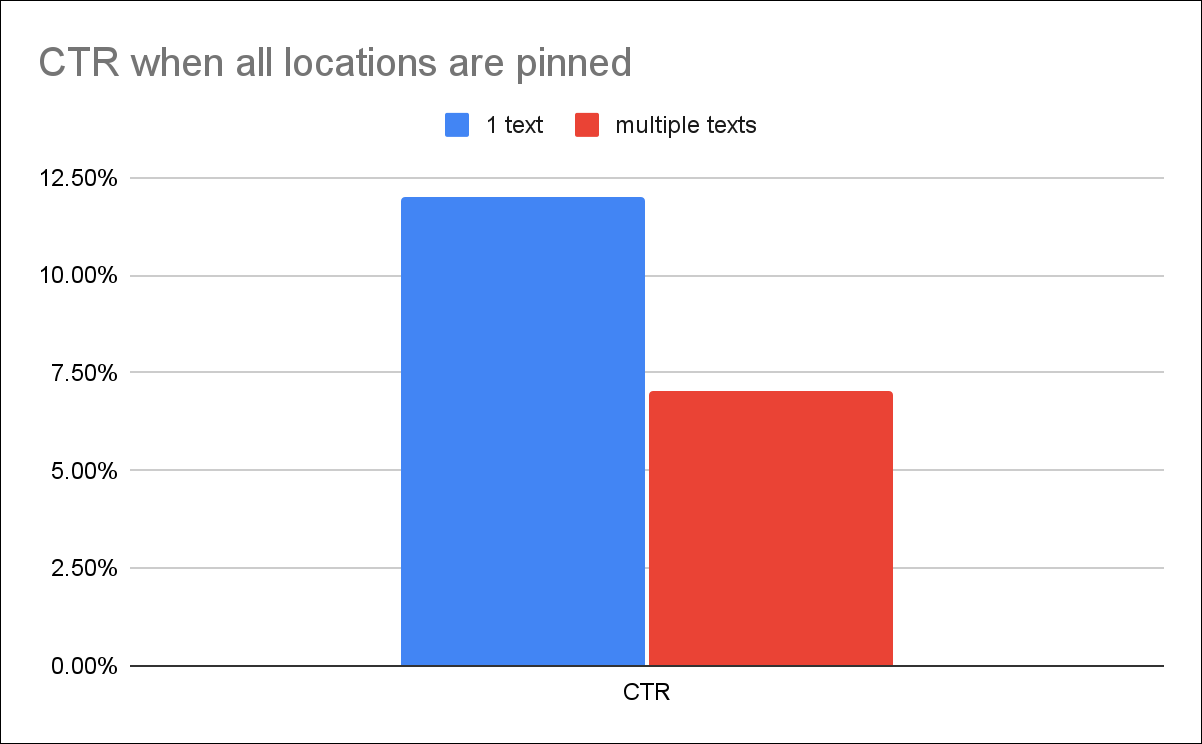
CTR is much better when pinning one text.
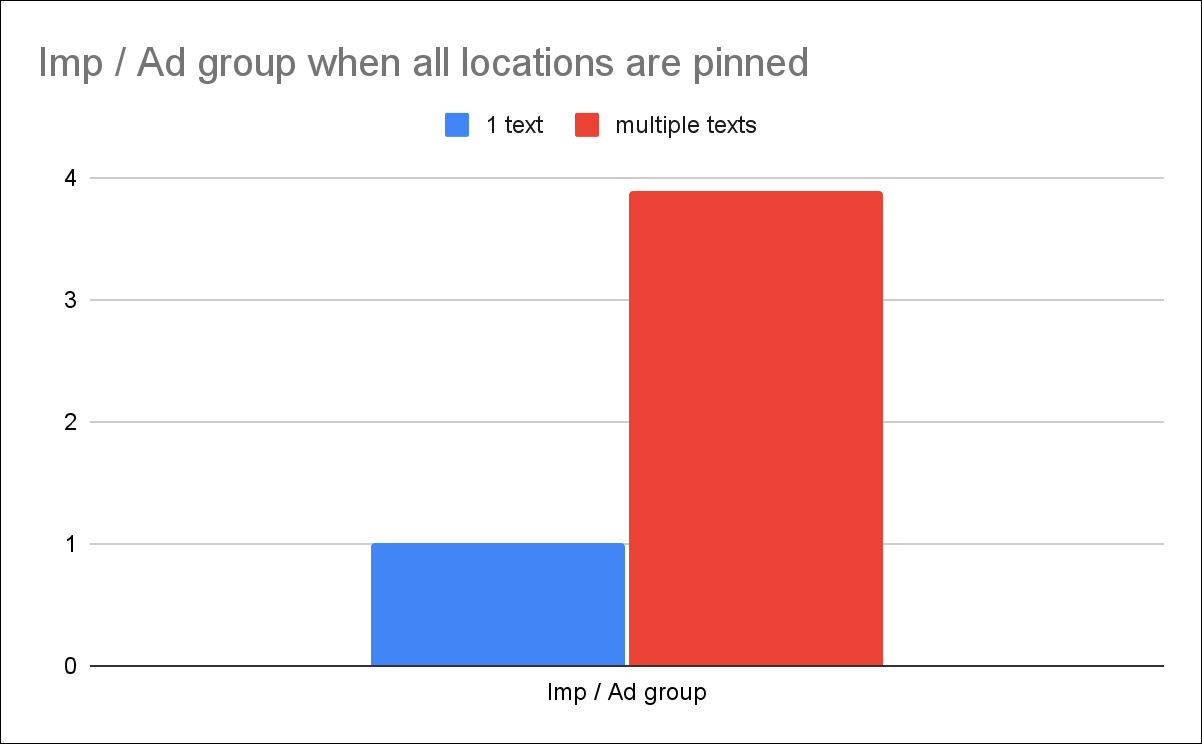
But impressions per ad group are 3.9 times higher when giving Google the flexibility with multiple texts per pinned location.
Optmyzr’s Interpretation: Advertisers who’ve spent several years optimizing their ETAs are creating “fake” ETAs by pinning one text at every position to recreate those strongest-performing ETAs.
Statistics on Responsive Search Ads and number of headlines
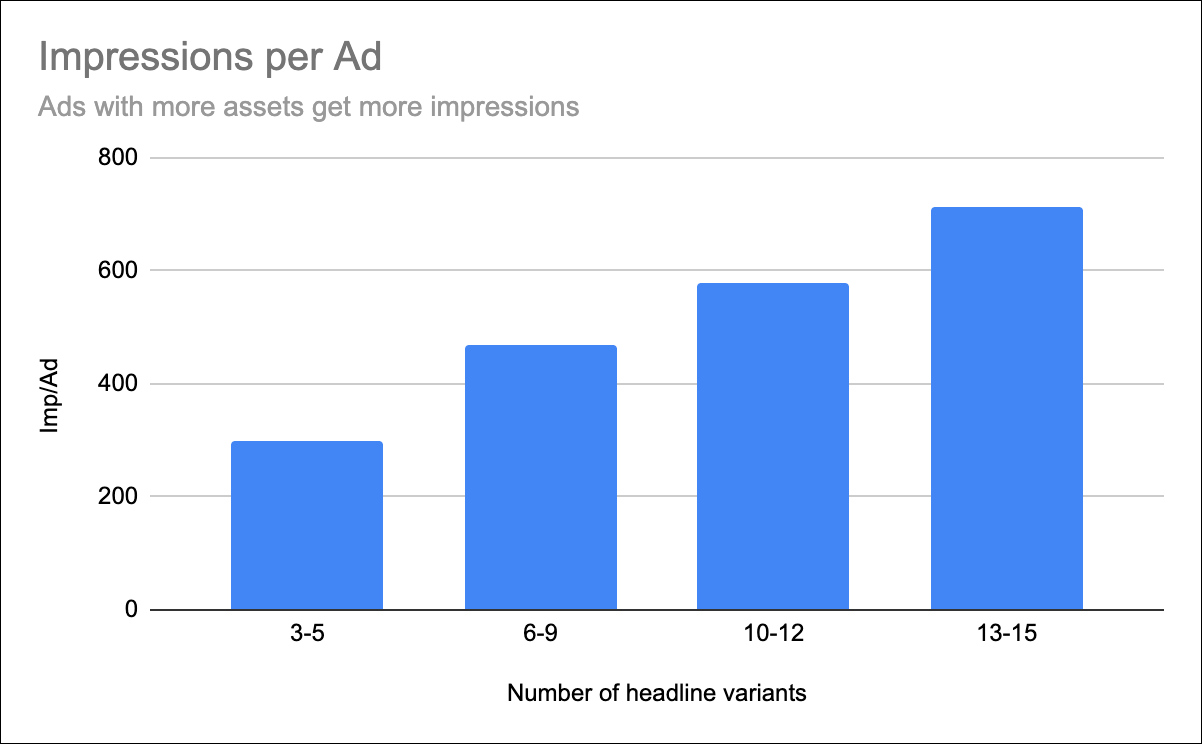
Responsive Search Ads can have up to 15 different headlines for Google to combine in different ways. And we’ve found that more headline variants lead to more impressions per RSA.
We’ve also seen GPT-3 getting quite good at suggesting ads for PPC managers to review.
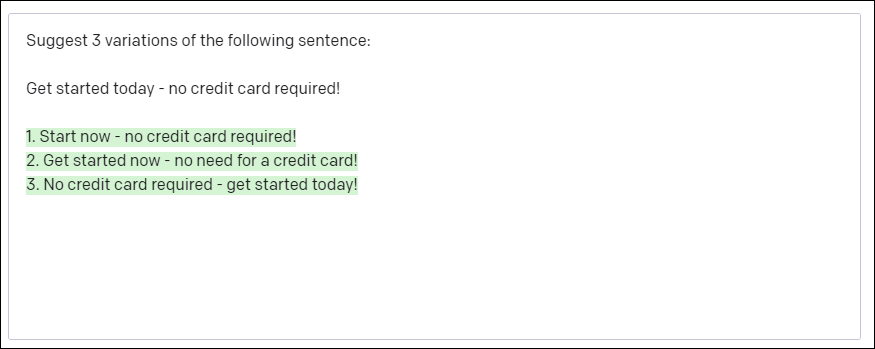
After analyzing 432,343 ads, we’ve also observed that adding Dynamic keyword insertion/ad customizers to RSAs increases the impressions per ad. On the flip side, there is a decrease in conversions per ad.
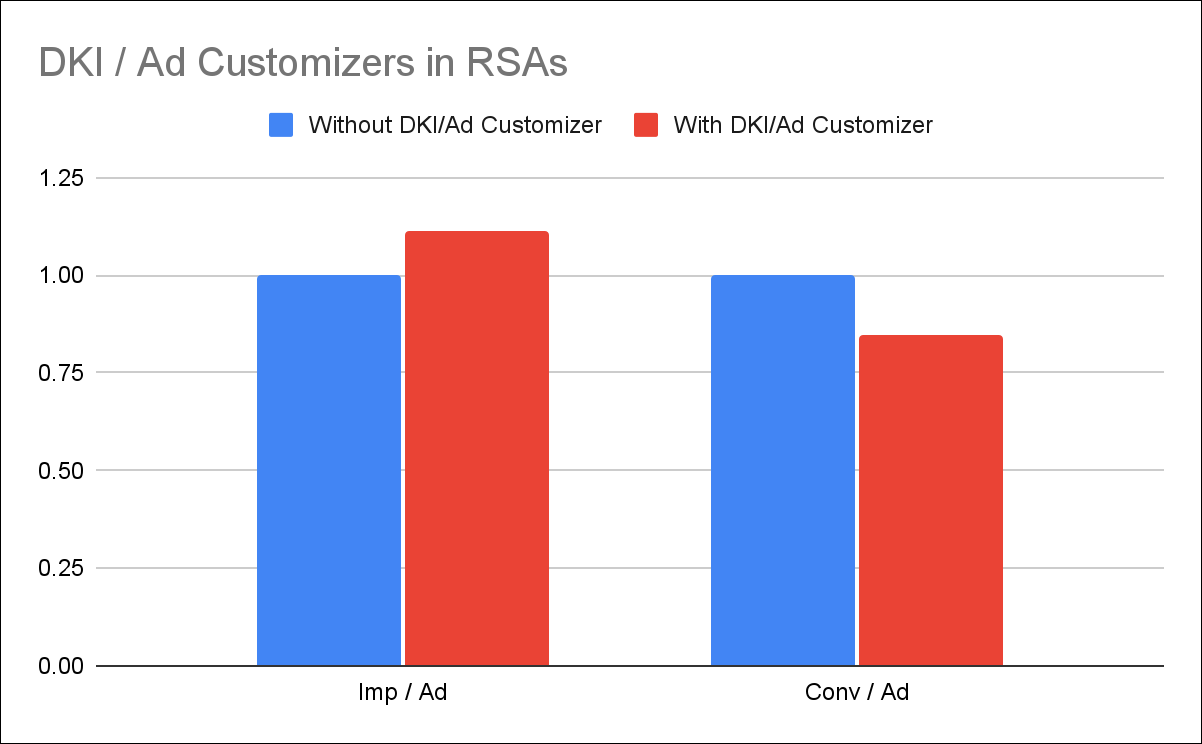
Optmyzr’s observation: The ads do look more relevant and hence get more clicks, but they can’t always deliver on the promise of what was automatically inserted in the text. Adding DKI or ad customizers to RSAs can decrease performance.
Statistics on financial performance of Responsive Search Ads vs. Expanded Text Ads
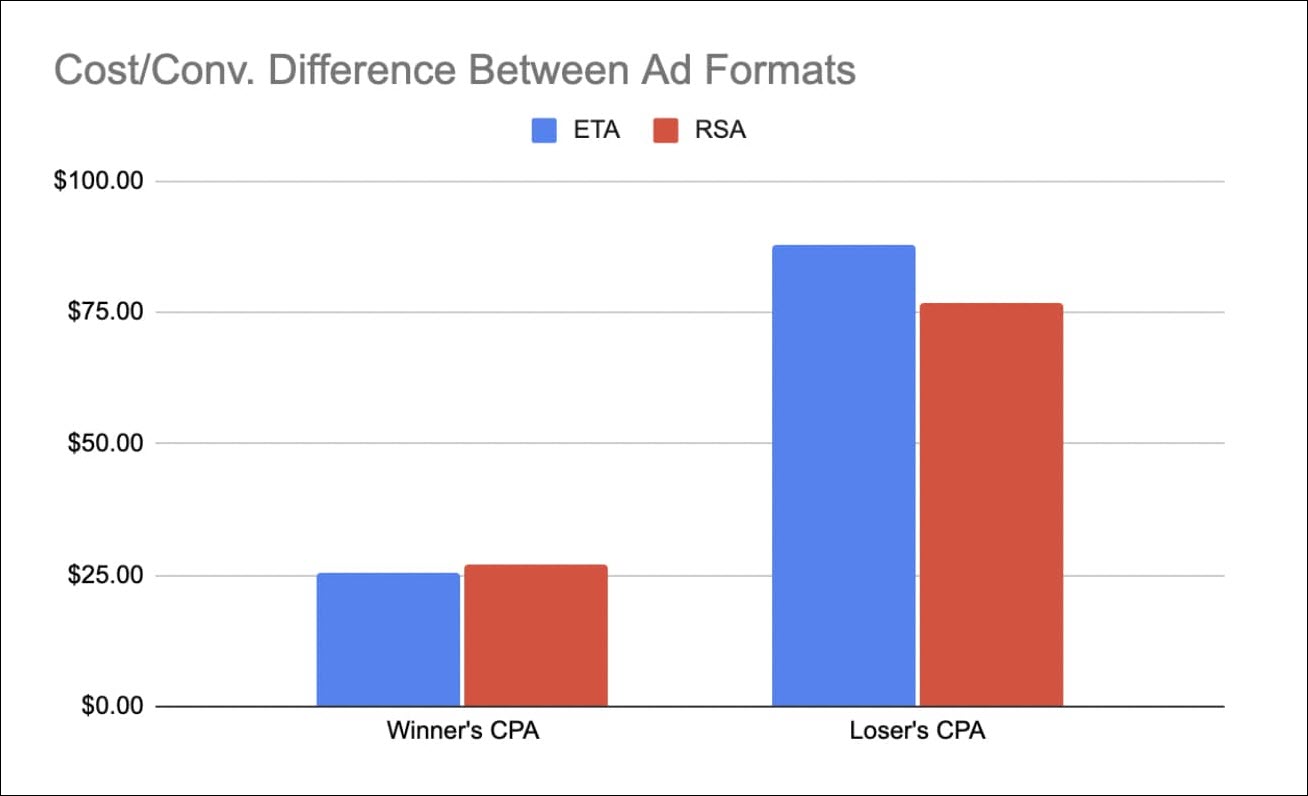
Responsive Search Ads can have up to 15 different headlines for Google to combine in different ways, but you only need to provide three – anything more is optional. We grouped each ad based on the number of headlines, further segmenting them by metric.
- When each ad type wins its ad group, RSAs average out at a $1.48 higher cost per acquisition than ETAs. However, they also cost an average of $10.96 less when they lose.
- This means that RSAs offer comparable winning performance to ETAs while saving significant costs when they lose. This trend extends to other financial metrics like ROAS and cost per click.
Responsive Search Ads Best Practices: Stay in control of PPC in the automation era
We don’t believe that either Responsive Search Ads or Expanded Text Ads are definitively better than the other.
So much of success in PPC depends on individual account needs, client relationships, global and market volatility, supply chains, and the expertise of the marketing and business teams involved.
However, the fact remains that you won’t be able to create any new Expanded Text Ads (or edit existing ones) now.
These next sections cover our recommendations to help you get started with managing this transition. As always, use them as thought-starters in the context of your client or brand’s specific goals.
1. Know the difference between ad strength and asset labels.
Ad strength is a best-practice score that measures the relevance, quantity, and diversity of your Responsive Search Ad content even before your RSAs serve.
Every increase in ad strength provides approximately 3% click uplift e.g. poor to average, average to good. However, it has no relation to performance.
Asset labels, on the other hand, give you guidance on which assets are performing well and which ones you should replace after your RSAs serve. These suggestions from Google are based on performance data, so if one of your assets doesn’t get impressions in 2+ weeks, you might want to replace it.
2. Build evergreen Expanded Text Ads (if you can).
While you can’t create new ETAs, any existing ones will continue to serve for as long as you like. You can pause and resume these ETAs, but you won’t be able to edit them in any way – that includes bids, keywords, ad text, targeting, and even budgets.
However, that won’t be an issue if you happen to have some evergreen campaigns or ad groups that you know can run without those modifications – possibly top-of-funnel brand campaigns or for a product line that you’re confident won’t go away.
Keep in mind that not every brand will have (or can afford) these opportunities, and even the ones that do may have to accept that those ads will need to be retired at some point – like if a key supplier goes out of business or the brand changes its name.
3. Start finding the pieces of your new Responsive Search Ads.
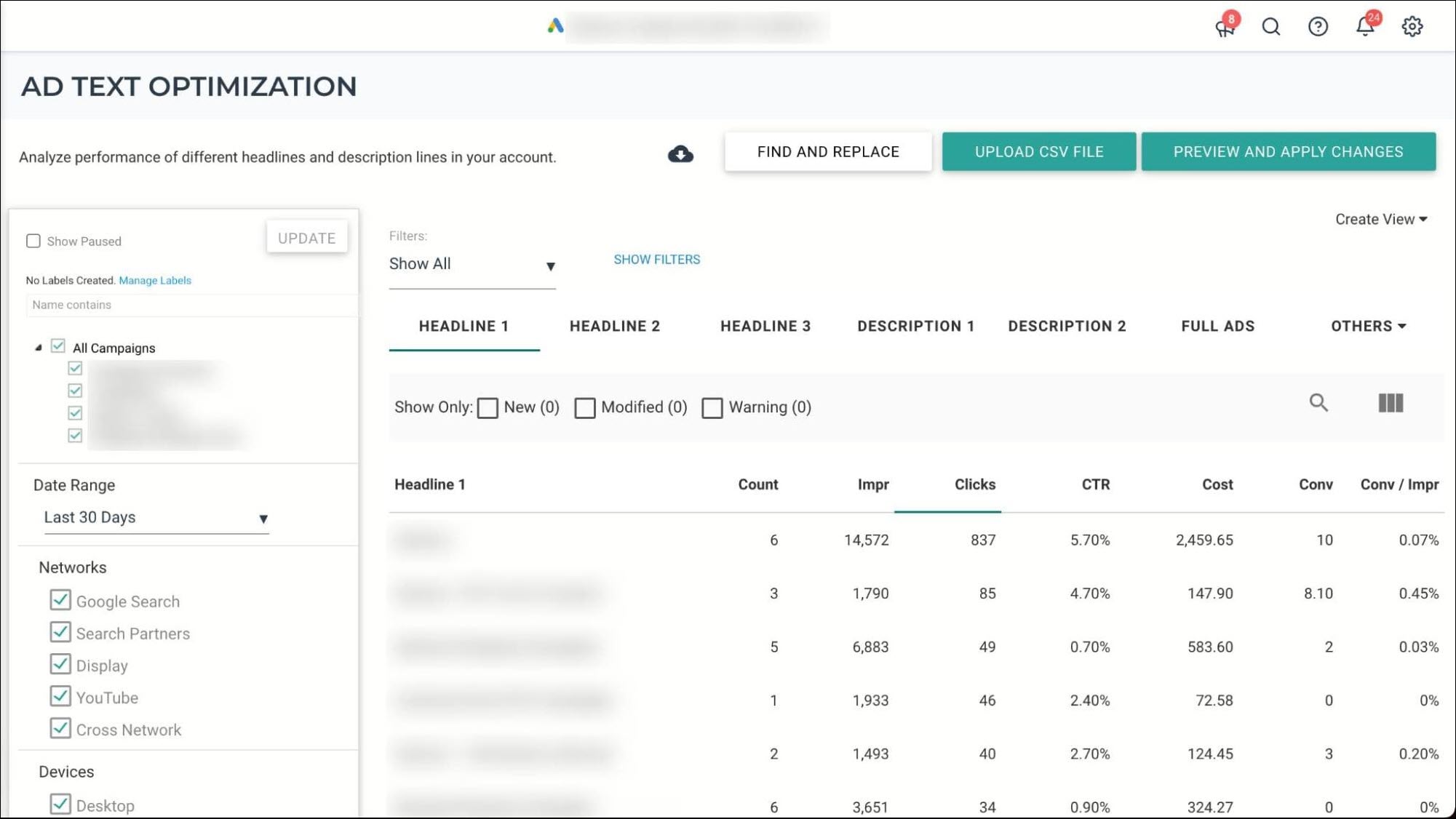
Ad Text Optimization lets you quickly find the best-performing text in your account
If your campaigns have been running for some time, there’s a good chance that you already have some quality RSAs floating around in different ad groups. It’s finding these individual components that can prove time-consuming and error-prone.
Fortunately, a tool like the Ad Text Optimization function in Optmyzr can make light work of that, allowing you to sort through single or multiple campaigns in minutes.
Our tool allows you to sort by element type (headline, description, path), individual placement, or even full ads to find the best-performing elements for the desired metric.
Once you have your ad text ready, you can bring the process full circle:
- Build a new ad with our Responsive Search Ad Utility
- Monitor the performance of RSAs and make necessary changes to ensure they are performing at their best using Ad Text Optimization (RSA) (read help article here)
- Migrate your existing ETAs to RSAs quickly using our free script
- Use our Rule Engine strategy to Find and Fix Underperforming RSAs
- Validate your findings in the AB Testing for Ads tool
4. Consider variety in your Responsive Search Ads.
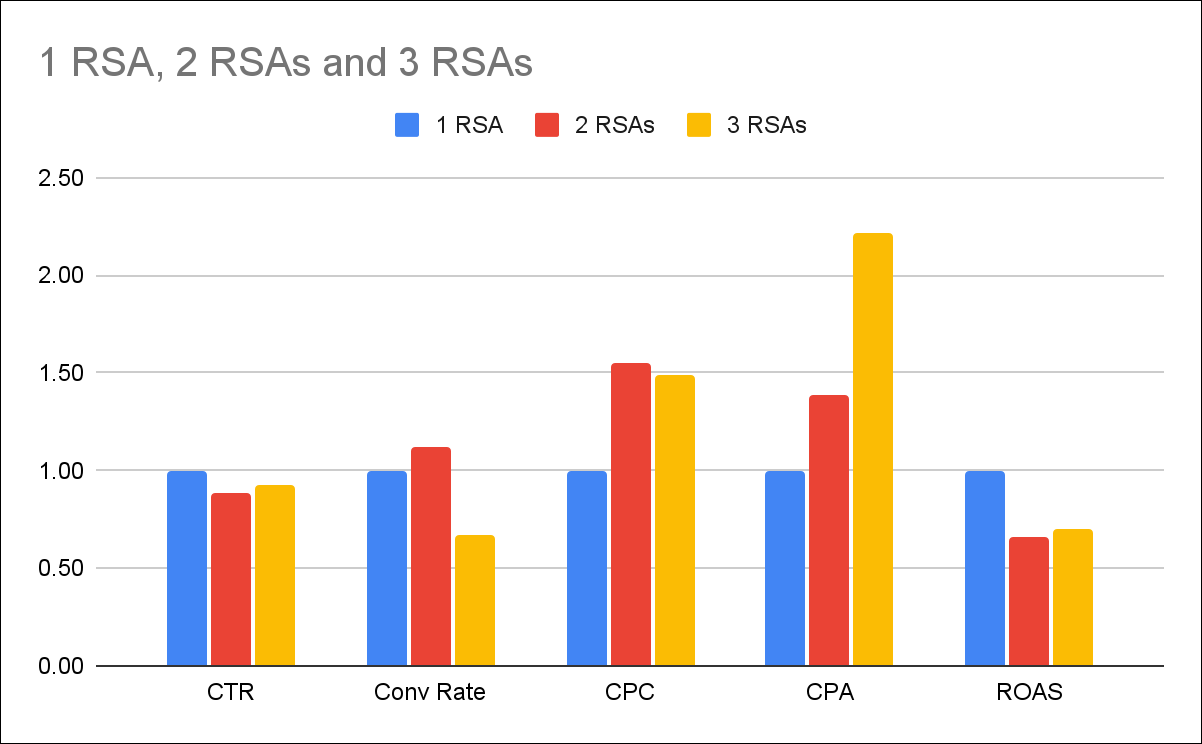
Key metrics for RSAs vary by the number of ads in an ad group
While you can create up to three Responsive Search Ads in one ad group, it’s difficult to find a consensus on the optimal number.
On the one hand, too many RSAs can dilute your messaging variations – especially if each one carries the full 15 headlines and four descriptions. But limiting yourself may not always be the right move either, assuming each RSA is distinct in terms of what it addresses.
The findings from our study show that ad groups with more RSAs tend to get significantly more impressions, but ad groups with two RSAs experience a surge in conversion rate that single-RSA and three-RSA ad groups don’t.
Having 2 RSA ads per ad group seems to be the sweet spot mostly based on improved conversion rates
As always, consider the merits of every situation and ad group individually.
5. Decide whether to pin elements in your Responsive Search Ads.

Google identifies excessive pinning as one of the 8 causes of weakened RSA ad strength, and while it’s not clear at what threshold this changes, it’s safe to say that your results will get weaker the more elements you pin.
However, some advertisers will need to pin specific pieces of text, such as disclaimers and warnings for those in legal or pharmaceutical advertising. Google is yet to comment on whether these industries with obligations will be assessed differently, or whether a new element will be made available to cater to this need.
For now, advertisers will have to do what they must with what they have access to. Just reconsider if you’re thinking about gaming the system by pinning all your elements to create a pseudo-Expanded Text Ad.
6. Change how you think about A/B testing with RSAs.
The methodology of A/B ad testing has long been premised on the assumption that impression volume is determined primarily by keywords and is only minimally dependent on the ad. This assumption is false with Responsive Search Ads.
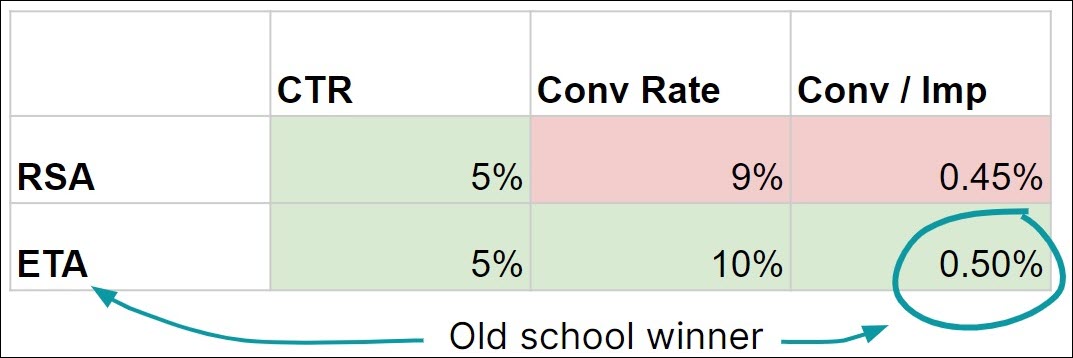
Old Way: Focused on conversion rates or conversions per impression
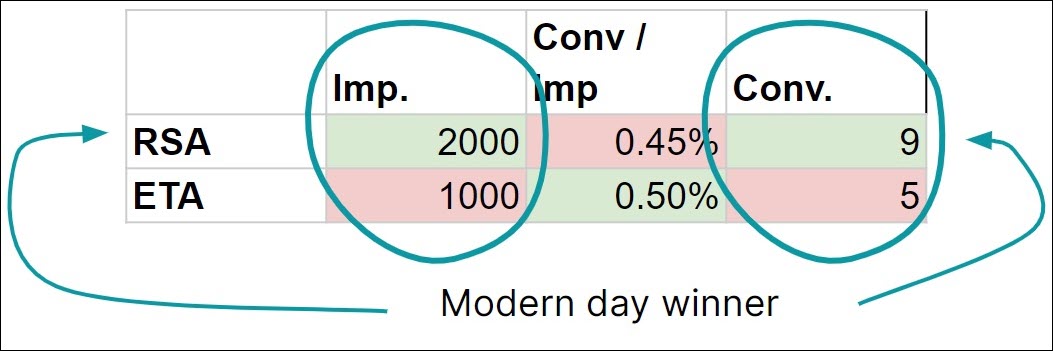
New Way: Focused on conversions within CPA or ROAS limits
7. Take out a PPC insurance policy with automation layering.
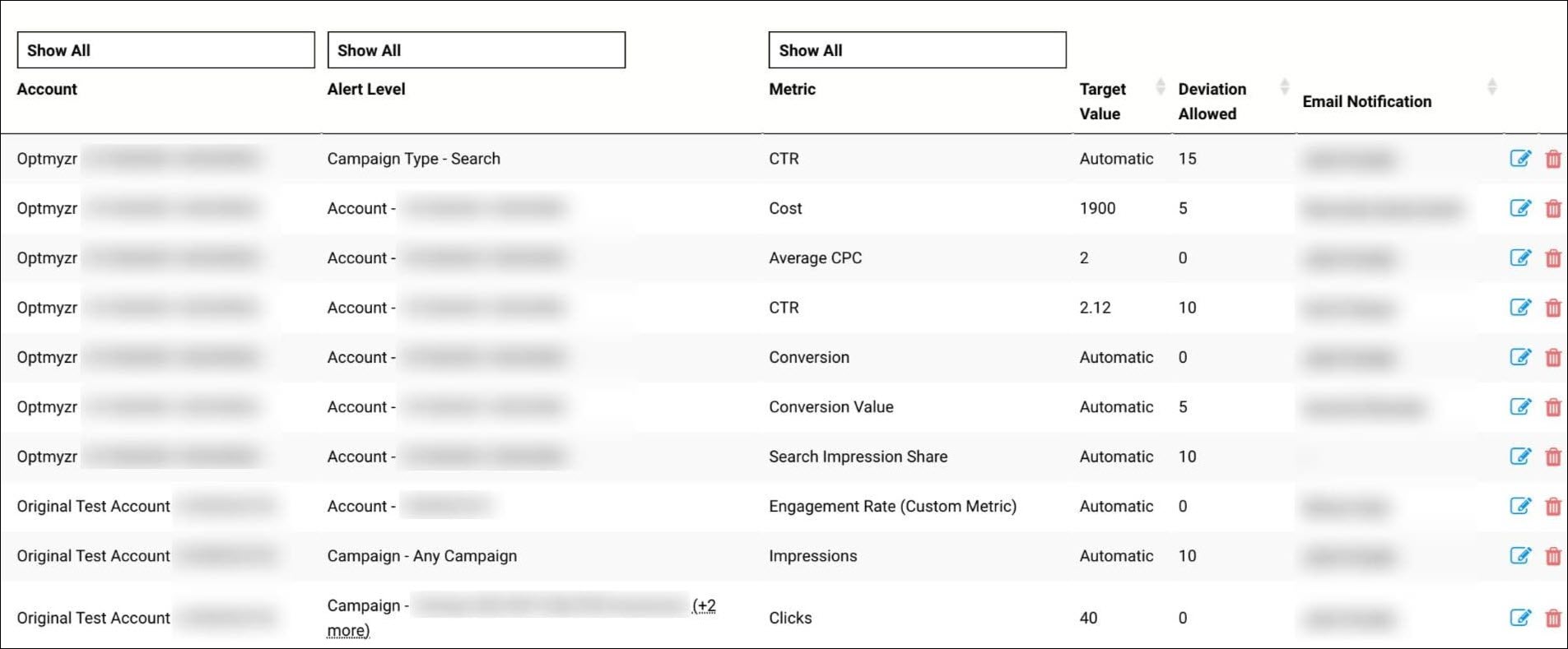
A list of active alerts at multiple levels in Optmyzr
Maybe you’ve had success with your search campaigns by determining large parts of their optimization strategies, or maybe you’ve been using automated bidding strategies in tandem with solidly built Expanded Text Ads that you control.
Performance Max in itself is not a direct threat to your account – you can always opt out of them unless you plan to use a Local or Smart Shopping campaign, both of which will be absorbed by Performance Max.
However, the double whammy of switching to Responsive Search Ads and running a Performance Max campaign together can be a risk for all but the most insulated PPC accounts. We suggest tackling one at a time.
Even then, the more Google automates their platform, the more vital it becomes for you to have a layer of automation working for the benefit of your account. A tool like Optmyzr makes that all the more possible – and effective.
Optmyzr users get access to all types of budget-related and metric-based alerts, giving them the ability to intervene as soon as signs of trouble begin to show. There’s also the Rule Engine, one of our most popular tools that lets you create rule-based automation for anything you can think of.
Best of all, you can switch it all off whenever you like.
But first, revisit your account structure.
Before doing anything, it’s important to understand how any brand’s individual transition to the Responsive Search Ad era will impact its account structure. Some of the questions you’ll need to answer include:
- Which campaigns and ad groups will continue to serve Expanded Text Ads?
- Which ad groups need new Responsive Search Ads? How many in each?
- Do I need to create new campaigns to avoid mixing RSAs and ETAs?
- How will I monitor the performance of legacy and new ads/campaigns?
One of the best places you can start is with Aaron Levy’s session from our UnLevel virtual conference in May 2021. In 40 minutes, Aaron shares a framework for building an account structure that is adaptable to the rapid change and increased automation that have come to define modern-day PPC.
This article repurposes portions of Frederick Vallaeys’ presentation on Responsive Search Ad performance from SMX Advanced 2022.
This article was originally written on Aug 17, 2022. It has been updated on April 7, 2023.
Get actionable PPC tips, strategies, and tactics from industry experts to your inbox once a month.








